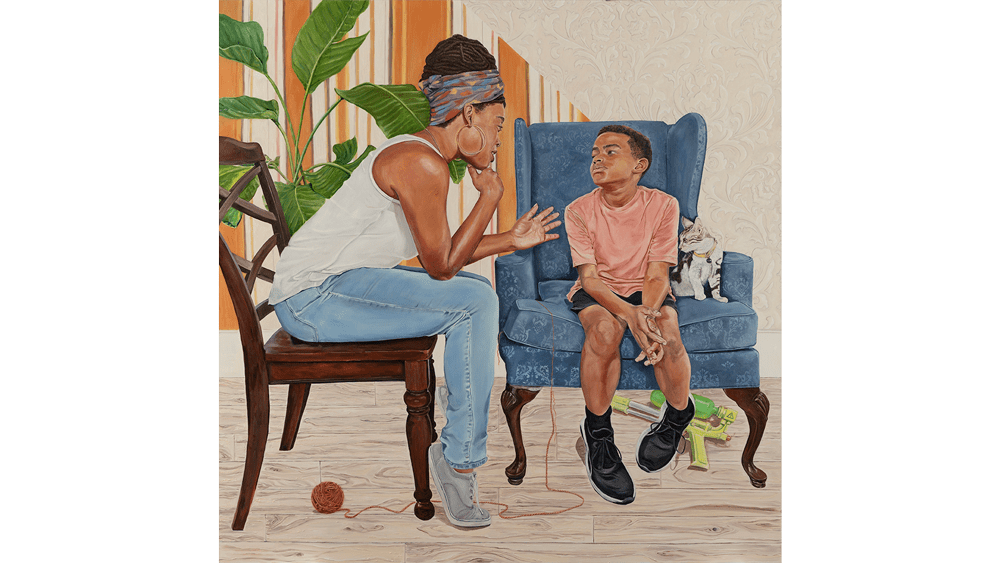

When Ayana Ross heard that the Bennett Prize had opened its call for submissions, back in 2020, she almost didn’t apply.
“I certainly didn’t see myself at that time as being suited for it,” she admits, calling from her home studio in McDonough, Ga. “But over a series of months, whenever I would talk on the phone with a friend from undergrad, she would remind me: ‘Okay, have you applied?’”
Good thing she did. Out of ten talented finalists selected from nearly 700 applicants, Ross walked away with the $50,000 prize, the largest of its kind offered solely to women figurative painters. (Her win was preceded by Aneka Ingold’s, who received the inaugural Bennett Prize in 2019, and succeeded by Shiqing Deng’s, who won the third Bennett Prize in 2023.) The prize also includes a touring solo exhibition, which Ross titled “The Lessons I Leave You”; still making its way across the country after opening last May, the show is currently on view at the Customs House Museum in Clarksville, Tenn.

Since winning the prize in 2021, Ross’s career has taken off. She recently opened yet another solo show, “Whence We Came,” at the Reading Public Museum in Pennsylvania, and is currently a Mellon Arts & Practitioner Fellow at Yale University. One is hard-pressed to find paintings in her portfolio not marked as “sold.”
Now, the Bennett Prize is moving into its fourth year, with the call for entries open from April 15 to October 4. As with previous years, a jury will select ten finalists, with a winner and runner up to be announced at the opening reception for the finalists’ exhibition at the Muskegon Museum of Art in Michigan on May 15, 2025. Unlike previous years, the 2024 Bennett Prize’s jurors are all women: artists Angela Fraleigh and Margaret Bowland; Gloria Groom, curator at the Art Institute of Chicago; and Dr. Elaine Melotti Schmidt, Bennett Prize co-founder.
Steven Alan Bennett, Schmidt’s husband and fellow prize co-founder, says Ross’s success “has ratified everything we’d hoped for when we conceptualized the Bennett Prize.”

“She’s selling her art. She’s traveling. She’s a fellow. She’s making a lot of paintings and experimenting with the bookends,” he says. “Everything we could possibly have conceptualized at the beginning is being realized in her.”
Though Ross is now based in McDonough, about 30 miles southeast of Atlanta, she grew up at the opposite end of the state, in smalltown Baxley (population 5,000). With a degree in apparel design and merchandising from Georgia Southern University, she started her career in the fashion industry, in New York City.
Then, 9/11 happened. For months, she heard sirens from her downtown office every time another body was recovered at Ground Zero. “It was difficult to focus on sleepwear and intimate apparel design in the aftermath of that,” she says.
Ross moved back home to teach art, working with students from pre-K up to college. At first, she experimented with textiles, hoping to build on her experience in the fashion industry. But she recognized the introverted, solitary side of herself in the abridged painter biographies she taught in class: Henry Tanner, Norman Rockwell, Amy Sherrell, Kehinde Wiley, Bo Bartlett. One day, a frustrating shopping trip cemented her path forward.

“I would get so frustrated going to Hancock and JoAnn’s [two fabric stores] and not finding exactly what I wanted. And then, it hit me: I’m a painter. I can literally paint the color I want,” she recalls.
Teaching full-time meant Ross, in those early days, had to make compromises. A mother, she could only find time to paint at four o’clock in the morning, before her long days in the classroom. At the time, she had to limit herself to small-scale work, in the interest of churning out more canvases. “It was something I could get done pretty quickly,” she says.
The Bennett Prize’s $50,000 award changed all of that practically overnight. It gave Ross permission to, in her words, “fail fabulously.”
“I had that two-year period to produce work for the solo exhibition, and just to produce work in general. The Bennett Prize allowed me the space and time to really produce in the way that I wanted to,” she says.

It even changed the work itself. Ross doesn’t find that the themes and concerns of her work are any different: her figurative work still probes family histories—with a special focus on dignified portrayals of youths and elders—and “finding revelations in small moments.” But its scale has absolutely changed.
“I believe that the size of the figure changes how you relate to that figure, and I really wanted to create life-size images that were in direct conversation with the viewer. [The Bennett Prize] gave me an opportunity to do that… Just having the opportunity to be a part of it put me on a different playing field.”
And that friend who pushed her to take the leap and apply? “She was there to celebrate with me,” Ross says, smiling at the memory.
For full details on how to apply for The Bennett Prize, please visit: thebennettprize.org.